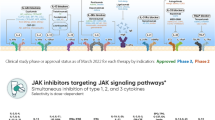Abstract
Inflammation can be mediated by invading microbial pathogens. Toll-like receptors (TLRs) recognize invading microbial pathogens, inducing innate immune responses. Broadly, the activation of TLRs induces two major downstream signaling pathways, myeloid differential factor 88 (MyD88)- and Toll/interleukin 1 receptor domain-containing adapter inducing interferon-β (TRIF)-dependent pathways, which lead to the activation of nuclear factor-κB (NF-κB) and interferon regulatory factor 3 (IRF3). To evaluate the therapeutic potential of the ethanol extracts of flowers of Eupatorium japonicum Thunb (EJE), its effect on signal transduction via the TLR signaling pathways induced by lipopolysaccharide (LPS) or polyinosinic-polycytidylic acid (poly[I:C]) was examined. EJE suppressed the activation of NF-κB and IRF3 induced by LPS or poly[I:C]. EJE also inhibited LPS- or poly[I:C]-induced IRF3 phosphorylation as well as interferon-inducible genes, such as interferon inducible protein-10. These results suggest that EJE can modulate TLR signaling pathways, realizing effective therapeutic options for chronic inflammatory diseases.
Similar content being viewed by others
References
Kumar H, Kawai T, Akira S. Pathogen recognition by the innate immune system. Int. Rev. Immunol. 30: 16–34 (2011)
Akira S, Takeda K. Toll-like receptor signalling. Nat. Rev. Immunol. 4: 499–511 (2004)
Takeda K, Akira S. Toll-like receptors in innate immunity. Int. Immunol. 17: 1–14 (2005)
Akira S, Uematsu S, Takeuchi O. Pathogen recognition and innate immunity. Cell 124: 783–801 (2006)
Fitzgerald KA, McWhirter SM, Faia KL, Rowe DC, Latz E, Golenbock DT, Coyle AJ, Liao SM, Maniatis T. IKKepsilon and TBK1 are essential components of the IRF3 signaling pathway. Nat. Immunol. 4: 491–496 (2003)
Kawai T, Takeuchi O, Fujita T, Inoue J, Muhlradt PF, Sato S, Hoshino K, Akira S. Lipopolysaccharide stimulates the MyD88-independent pathway and results in activation of IFN-regulatory factor 3 and the expression of a subset of lipopolysaccharideinducible genes. J. Immunol. 167: 5887–5894 (2001)
Gao JJ, Filla MB, Fultz MJ, Vogel SN, Russell SW, Murphy WJ. Autocrine/paracrine IFN-alphabeta mediates the lipopolysaccharideinduced activation of transcription factor Stat1alpha in mouse macrophages: pivotal role of Stat1alpha in induction of the inducible nitric oxide synthase gene. J. Immunol. 161: 4803–4810 (1998)
Bjorkbacka H, Fitzgerald KA, Huet F, Li X, Gregory JA, Lee MA, Ordija CM, Dowley NE, Golenbock DT, Freeman MW. The induction of macrophage gene expression by LPS predominantly utilizes Myd88-independent signaling cascades. Physiol. Genomics 19: 319–330 (2004)
Murakami A, Ohigashi H. Targeting NOX, INOS, and COX-2 in inflammatory cells: Chemoprevention using food phytochemicals. Int. J. Cancer 121: 2357–2363 (2007)
Gu GJ, Eom SH, Shin HJ, Paek JH, Kim S, Lim SS, Youn HS. Japanese bog orchid (Eupatorium japonicum) extract suppresses expression of inducible nitric oxide synthase and cyclooxygenase-2 induced by Toll-like receptor agonists Food Sci. Biotechnol. 22: 811–815 (2013)
Youn HS, Ahn SI, Lee BY. Guggulsterone suppresses the activation of transcription factor IRF3 induced by TLR3 or TLR4 agonists. Int. Immunopharmacol. 9: 108–112 (2009)
Ahn SI, Lee JK, Youn HS. Inhibition of homodimerization of Tolllike receptor 4 by 6-shogaol. Mol. Cells 27: 211–215 (2009)
Youn HS, Saitoh SI, Miyake K, Hwang DH. Inhibition of homodimerization of Toll-like receptor 4 by curcumin. Biochem. Pharmacol. 72: 62–69 (2006)
Park SJ, Yun SM, Lee AN, Ahn SI, Lee MY, Youn HS. Costunolide inhibits cyclooxygenase-2 expression induced by Toll-like receptor 3 or 4 agonist. Toxicol. Environ. Health Sci. 1: 122–126 (2009)
Yoneyama M, Suhara W, Fukuhara Y, Fukuda M, Nishida E, Fujita T. Direct triggering of the type I interferon system by virus infection: Activation of a transcription factor complex containing IRF-3 and CBP/p300. EMBO J. 17: 1087–1095 (1998)
Youn HS, Lee JY, Fitzgerald KA, Young HA, Akira S, Hwang DH. Specific inhibition of MyD88-independent signaling pathways of TLR3 and TLR4 by resveratrol: Molecular targets are TBK1 and RIP1 in TRIF complex. J. Immunol. 175: 3339–3346 (2005)
Park SJ, Youn HS. Isoliquiritigenin suppresses the Toll-interleukin-1 receptor domain-containing adapter inducing interferon-beta (TRIF)-dependent signaling pathway of Toll-like receptors by targeting TBK1. J. Agr. Food Chem. 58: 4701–4705 (2010)
Park SJ, Lee MY, Son BS, Youn HS. TBK1-targeted suppression of TRIF-dependent signaling pathway of Toll-like receptors by 6-shogaol, an active component of ginger. Biosci. Biotech. Bioch. 73: 1474–1478 (2009)
Kim TK, Maniatis T. The mechanism of transcriptional synergy of an in vitro assembled interferon-beta enhanceosome. Mol. Cell 1: 119–129 (1997)
Grandvaux N, tenOever BR, Servant MJ, Hiscott J. The interferon antiviral response: From viral invasion to evasion. Curr. Opin. Infect. Dis. 15: 259–267 (2002)
Lin R, Heylbroeck C, Pitha PM, Hiscott J. Virus-dependent phosphorylation of the IRF-3 transcription factor regulates nuclear translocation, transactivation potential, and proteasome-mediated degradation. Mol. Cell Biol. 18: 2986–2996 (1998)
Lin R, Heylbroeck C, Genin P, Pitha PM, Hiscott J. Essential role of interferon regulatory factor 3 in direct activation of RANTES chemokine transcription. Mol. Cell Biol. 19: 959–966 (1999)
Schafer SL, Lin R, Moore PA, Hiscott J, Pitha PM. Regulation of type I interferon gene expression by interferon regulatory factor-3. J. Biol. Chem. 273: 2714–2720 (1998)
Honda K, Taniguchi T. IRFs: Master regulators of signalling by Toll-like receptors and cytosolic pattern-recognition receptors. Nat. Rev. Immunol. 6: 644–658 (2006)
Author information
Authors and Affiliations
Corresponding author
Rights and permissions
About this article
Cite this article
Gu, GJ., Ahn, SI., Lim, S.J. et al. Eupatorium japonicum extract regulates inflammation through suppression of the TRIF-dependent signaling pathway of toll-like receptors. Food Sci Biotechnol 23, 587–592 (2014). https://doi.org/10.1007/s10068-014-0080-x
Received:
Revised:
Accepted:
Published:
Issue Date:
DOI: https://doi.org/10.1007/s10068-014-0080-x




